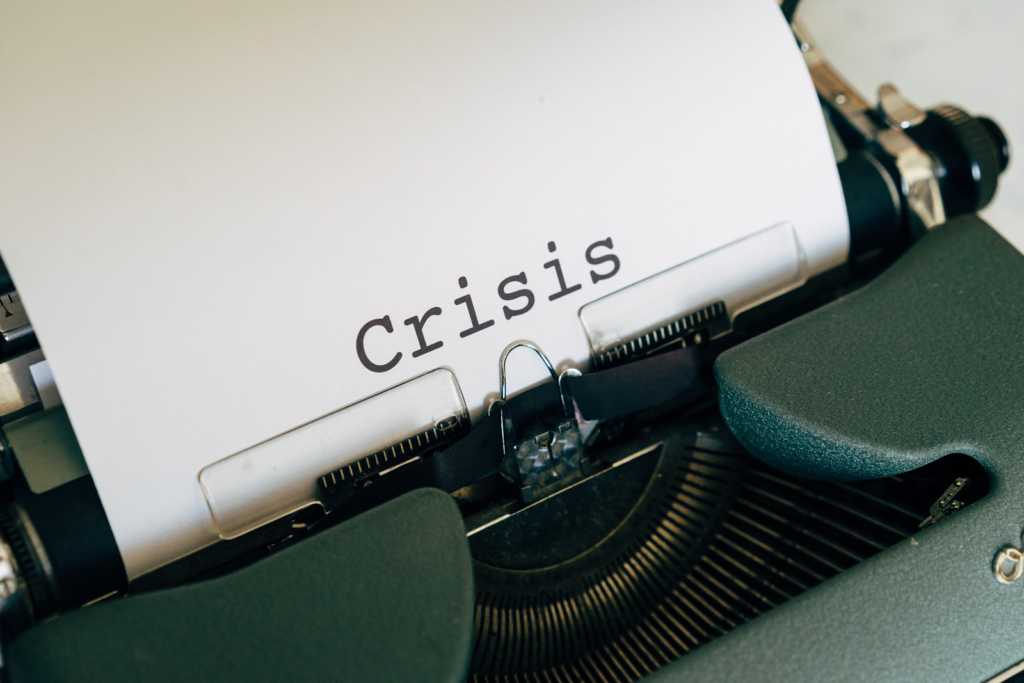© 23e2 Business Services Inc. | Working With 3rd Parties
How to Get Your Brand Message Right & Wrong in Times of Crisis

During times of crisis, businesses often struggle to convey their brand messages(especially smaller businesses).
How businesses conduct themselves during difficult times could affect their bottom line. So businesses need to take action so that they can come out ahead after a crisis.
There are two possible approaches for brands to market themselves during a crisis:
- Pivot quickly and take the necessary steps to best respond to the changing situation (fight).
- Continue to operate as normal and hope things will go back to normal soon (flight).
Ignoring the current situation sends a negative message to your audience and may negatively impact your brand image, resulting in loss of customers.
Smart and agile businesses are the ones who are constantly adapting their operations to best accommodate their customers during uncertain times:
- Local restaurants offering home delivery meals instead of dine-ins
- Banks offering ‘Zoom Workshops’ to help people develop new skills
- Hotel chains offering their now-empty rooms for hospital use.
- Burger King promotes a “quarantine Whopper” you can make at home.
A good example is Burger King’s response to the pandemic, by publishing their iconic Whopper recipe for customers to make at home, reminding customers that they can still enjoy a Whopper even if they are not able to visit a Burger King at the time. This will keep Burger King in the minds of the customers throughout the crisis, which will likely increase the number of visits once the pandemic is over.
Although your business may not be profiting at the moment, you should focus on building your brand for the long-term, by consistently reminding customers of your brand’s existence to encourage both existing and new customers to visit your business once the crisis is over.
In times of uncertainties, brands need to quickly reassess their current marketing strategy and make sure they are delivering the right messages to their customers in regards to the current situation.
Make sure to be genuine with your messaging and actions. Don’t try to capitalize on the situation – try to offer support. Most importantly, keep reminding customers of your brand – so that once the crisis is over they don’t forget about you.

How to Broadcast in a Pandemic
Don’t ignore what’s happening. Acknowledge the issue at hand and adapt your business to the change in situation.
Brands who continue to ignore the situation by sending emails and creating advertisements with their pre-crisis messages are at risk of being seen as unempathetic. This creates a disconnect between the brand and the customers.
To establish a stronger position once a crisis is over, a brand must get its messaging right by investing in new content strategies that are relevant to the current situation.
Tips for implementing a content strategy during a crisis:
- Directly addressing the situation and how this is affecting your audience.
- Empathize with your audience and show that you understand how they are feeling in the current moment.
- Identifying the support you can provide to your audience in this situation.
- When considering public relationship marketing, be sure to be genuine with your messaging, and avoid being seen as trying to profit from the situation.

5 Ways to Do Smart & Responsible Marketing During a Crisis
Here are some tips when considering your marketing approach during a crisis.
While every brand is different, this simplified action plan can help brands of all sizes make the right choices and avoid serious mistakes.
1) Adjust Marketing Campaigns and Scheduled Content Timelines
- Push timelines back on major campaigns that will likely be irrelevant in the current situation, or pause entirely if you’re not sure if the content is appropriate. If a campaign has some elements that aren’t appropriate right now, that doesn’t mean it needs to be scrapped altogether; it’s likely that the idea will still be relevant once the crisis subsides and things return back to normal.
- Consider what to prioritize or change. You may want to prioritize some ideas ahead of schedule or change messaging that is irrelevant to the current situation. You want to be understanding of the issue and make your business appear empathetic, not pushy. For example, a campaign centred around the theme of “get closer to your customers” can be changed to “support your customers” or “customer relationships matter.”
You should pay attention to the marketing efforts of other businesses in your geographic areas, as every region is handling the situation differently, so you can get an idea of how to best communicate your message.
2) Evaluate Your Imagery and Language
Imagery is a powerful communication tool, sometimes even more important than words. It’s important to think about the messages your brand is sending to both your current and potential customers.
Using the current pandemic as an example:
- Avoid visuals of crowds or people touching. This includes people working in offices or at social gatherings. You don’t want to seem as though you’re promoting those sorts of behaviours when social-distancing is encouraged.
- Refrain from using figurative language such as “get in touch,” “work hand in hand,” or “get closer to your customers.” Messages encouraging immediate interaction may be perceived as though you’re disconnected from the current events, and don’t care about the wellbeing of your customers.
- Swap out visuals. If you have current or upcoming campaign visuals that may not be relevant to the current situation, revise the imagery now or save the idea for a later time. Especially for “push” content – the content you are actively putting in front of people across channels during this time (e.g., email subject lines, social posts, current campaign taglines, content, blogs).
As crises are expected to be temporary, visitors will likely be more forgiving about pre-existing content. More permanent brand elements (e.g., your logo) or “pull” content (e.g., your homepage) can remain as it is – unless you’re promoting a large social event on your homepage, or your image involves large crowds or people touching. You can easily change things and customers will take notice and appreciate the effort.
3) Don’t Capitalize on the Crisis
It’s important to remember during times of uncertainty, don’t make it seem like you want to take advantage of the crisis to make a profit
- Keep people informed. Brands need to communicate their response to the crisis, as it pertains to their business. For example, you should update your audience about the current measures you’re taking, store closures, or policy updates related to COVID-19 or other crises. Although these messages tend to get memed on social media, they do add value to customer relationships because they are informative.
- Don’t spread fear. It’s important to keep people informed, but don’t add to the panic. Don’t use overly dramatic language, and pay attention to any additional information you’re sharing (e.g., credibly sourced news articles or tips).
- Mind your tone. No “COVID-19 sales!” or other insensitive advertising. Even if the communication isn’t offensive, it can still be perceived as clueless or ignorant.
- Avoid boasting. Remember that many people are not working at this time and are worried about their finances. A spirit of humility and empathy should be encouraged for anything your brand says in the near future. Don’t point out that your employees have jobs, instead, you can show your support by wishing everyone who continues to work to be safe.
4) Be Positive, But Not Ignorant
In times when people are uneasy, you don’t need to be overly positive, it may come off that you are happy about the current situation.
- Look to your brand’s purpose, vision, mission, and values for guidance. Times like these are when the work you’ve done to create a brand strategy can be incredibly valuable. Use your “brand heart” (purpose, vision, mission, and values) to remind yourself what your brand stands for, and what that means in the context of COVID-19 (or other crises).
- Be personable. You don’t have to strip your brand of its emotion. For example, offering your good wishes or using imagery of happy people isn’t offensive. In fact, it can be refreshing for people to recall their normal lives, and to stay hopeful that the crisis will be over soon.
- Think about your future messaging. During the later stages of the 2008-09 recession and the early years of economic recovery, many brands pivoted their campaigns to promote optimism, hope, and humanity. This should be a goal for your company, to consider how your current messaging will affect your future messaging.
- Create employee-generated content (EGC). Ask your teams for their favourite Netflix binges, share your tips for maintaining office plants while everyone is away, or post fun photos from your video conferences. Ask your employees what they’re doing in their spare time, and how people are working together to keep things light. What are people doing to stay healthy and prepared? This will be a great way to show your customers that you’re more than just a business and that you are going to get through the crisis together.
Remember: The more you show your human side, the more everyone can all feel connected – even if we’re stuck inside. “We’re all in this together” is a good message that you want to portray.
5) Highlight How Your Brand Can Help
If what you do supports or enhances people’s lives during a crisis, tell that brand story. Brands exist to provide value, and the products/services that help during this stressful time deserve the attention of those who can benefit from them.
- Communicate your benefits. Does your product give people things to do at home? Does it help people do their jobs without face-to-face interaction or commuting to an office? Clarify your brand’s unique value, and share it.
- Create helpful content. Even if your product doesn’t directly help people deal with the crisis, your brand can still provide value to people. How can you educate, entertain, or inspire people stuck at home all day? As long as you keep the focus on helping people and not solely on making a profit, your marketing doesn’t have to stop but should be encouraged. Remember that crises won’t last forever.
Brands Getting Their Message Right in the Crisis

Speedo
A great branding message is one from Speedo.Swimming is a great activity to promote physical health as well as helping people cope with their stress and problems. For some people, swimming is an integral part of some people’s lives, and during a crisis, that’s when they would need it the most.
Speedo nailed their message by really understanding their audience, as they offered messages of support and inspiration across social media to keep people going.They shared how professional athletes are struggling to continue with their training and the impact this could have on their career.
A few days after the first message, Speedo followed up with “5 Dry Land Exercises to Give You More Power in The Pool.” This really connected with their target audience, as they weren’t trying to sell them anything but instead Speedo was helping their customers improve themselves during these difficult times.
This is a great image to aim for as it can be done simply by providing some helpful tips. To keep itself in the customers’ mind, Speedo was creating content around helping people better themselves in this situation, not solely pushing their products. Helping their customers stay in shape will remind people of Speedo when they decide to start swimming again after the crisis is over.
The White Company
Luxury interiors and clothing company “The White Company” managed to address the current crisis but avoided any direct reference to it.
The company used the word ‘hibernation’ as it doesn’t quite reflect the current situation, but promotes positivity by taking attention away from the negative aspect of the ‘quarantine’.
Their content was very much on target with their audience as it recognizes that people will want to “nest” and find comfort during these times of stress.
They also recognize that their key demographic consists of children, and tries to help parents by offering tips and activities to keep kids entertained when they are stuck at home.
The White Company content strategy was successful, as their newsletters manage to connect their products to the situation in a relevant way.
Brand Getting Their Message Wrong in the Crisis

Massimo Dutti
Most brands will plan their editorial and content calendars long in advance. Especially in the fashion industry, with long lead times for range planning, production, and photoshoots.
Brands tend to invest massive budgets into campaigns to launch their new season products, but that is no excuse to continue to pursue it when it’s not appropriate to the current situation (even if a loss will be incurred), as it may come off as being insensitive.
There was an email from Massimo Dutti that was travel themed which was sent after the UK announced its lockdown. Advertising travel to customers when they can’t travel can be perceived as mocking the situations, and feels very insensitive as it endangers people’s lives.
In this case, Massimo Dutti’s message of ‘enjoy summer’ and images of walks on sunny beaches, city get-togethers and models in summer clothes leaning against palm trees were not appropriate with the current situation as everyone was advised to stay at home.
In addition, there was little consideration to the people who had lost money on booked holidays that they couldn’t refund due to the travel bans.
Massimo Dutti should reconsider their content marketing strategy and change their messaging to something that is more appropriate to the situation such as encouraging people to stay safe during these uncertain times, as opposed to traveling.
Final Thoughts
Take into account the tips provided, learn from the successful branding messages, and the unsuccessful one. It’s important to try and adapt your marketing strategies to be relevant to the current situation, and to be considerate of your audience and the messages you’re putting out there for them.
In times of crisis, it is understandable to feel anxious about the uncertainties of what will happen to your business. But those who come out on top in the end are the businesses who don’t panic and make smart decisions to best adapt to the situation. Most importantly your marketing efforts will determine the success of your business during and after the crisis, as that is your main form of communication between your brand and your customers. Constantly reminding customers about your brand will help your business build a stronger position for itself once everything returns to normal.
Everyone will face difficulties during times of crisis. It is important to remember that we are all in this together, and we should do everything we can to get through it together.

